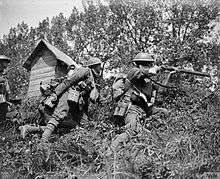Third Battle of the Aisne
- This article is about the 1918 battle. For other battles of the Aisne see Battles of the Aisne.
| Third Battle of the Aisne | |||||||
|---|---|---|---|---|---|---|---|
| Part of the Western Front of World War I | |||||||
 The Western Front, July 1918 | |||||||
| |||||||
| Belligerents | |||||||
|
|
| ||||||
| Commanders and leaders | |||||||
|
|
| ||||||
| Strength | |||||||
| French 6th Army, British IX Corps and later 2 American Divisions[Note 1] | German 1st and 7th Armies (over 20 divisions and 4,000 artillery guns) | ||||||
| Casualties and losses | |||||||
| 127,000 | 130,000 | ||||||
The Third Battle of the Aisne (French: 3e Bataille de L'Aisne) was a battle of the German Spring Offensive during World War I that focused on capturing the Chemin des Dames Ridge before the American Expeditionary Forces arrived completely in France. It was one of a series of offensives, known as the Kaiserschlacht, launched by the Germans in the spring and summer of 1918.
Background
The massive surprise attack (named Blücher-Yorck after two Prussian generals of the Napoleonic Wars) lasted from 27 May until 4 June 1918[1] and was the first full-scale German offensive following the Lys Offensive in Flanders in April.
The Germans held the Chemin des Dames Ridge from the First Battle of the Aisne in September 1914 to 1917, when General Mangin captured it during the Second Battle of the Aisne (in the Nivelle Offensive).
Operation Blücher-Yorck was planned primarily by Erich Ludendorff, who was certain that success at the Aisne would lead the German armies to within striking distance of Paris. Ludendorff, who saw the British Expeditionary Force as the main threat, believed that this, in turn, would cause the Allies to move forces from Flanders to help defend the French capital, allowing the Germans to continue their Flanders offensive with greater ease. Thus, the Aisne drive was to be essentially a large diversionary attack.
The defense of the Aisne area was in the hands of General Denis Auguste Duchêne, commander of the French Sixth Army. In addition, four divisions of the British IX Corps, led by Lieutenant-General Sir Alexander Hamilton-Gordon, held the Chemin des Dames Ridge; they had been posted there to rest and refit after surviving the "Michael" battle.
Battle

On the morning of 27 May 1918, the Germans began a bombardment (Feuerwalze) of the Allied front lines with over 4,000 artillery pieces. The British suffered heavy losses, because Duchene was reluctant to abandon the Chemin des Dames ridge, after it had been captured at such cost the previous year, and had ordered them to mass together in the front trenches, in defiance of instructions from the French Commander-in-Chief Henri-Philippe Petain. Huddled together, they made easy artillery targets.[2]
The bombardment was followed by a poison gas drop. Once the gas had lifted, the main infantry assault by 17 German Sturmtruppen divisions commenced, part of an Army Group nominally commanded by Crown Prince Wilhelm, the eldest son of Kaiser Wilhelm II. The Kaiser came to inspect the progress of the battle. He interviewed captured British Brigadier-General Hubert Rees (GOC 150th Brigade, part of 50th Division). The Kaiser was amused to learn that he was Welsh, the same nationality as Lloyd George.[3]
Taken completely by surprise and with their defences spread thin, the Allies were unable to stop the attack and the German army advanced through a 40 kilometres (25 mi) gap in the Allied lines. Reaching the Aisne in under six hours, the Germans smashed through eight Allied divisions on a line between Reims and Soissons, pushing the Allies back to the river Vesle and gaining an extra 15 km of territory by nightfall.
Victory seemed near for the Germans, who had captured just over 50,000 Allied soldiers and over 800 guns by 30 May 1918. But advancing within 56 kilometres (35 mi) of Paris on 3 June, the German armies were beset by numerous problems, including supply shortages, fatigue, lack of reserves and many casualties.
On 6 June 1918, following many successful Allied counter-attacks, the German advance halted on the Marne, much as the "Michael" and "Georgette" offensives had in March and April of that year.
Aftermath
The French had suffered over 98,000 casualties and the British around 29,000. German losses were nearly as great, if not slightly heavier. Duchene was sacked by French Commander-in-Chief Philippe Petain for his poor handling of the British and French troops. The Americans had arrived and proven themselves in combat for the first time in the war.
Ludendorff, encouraged by the gains of Blücher-Yorck, launched further offensives culminating in the Second Battle of the Marne.
See also
References
Notes
- ↑ The divisions of American Expeditionary Force were double the size of those of the British, French and Germans (with a full strength of around 20,000 each). Due to this fact, they were sometimes referred to as Grandes Divisions (Big Divisions).
Citations
- ↑ "The German Spring Offensive March–July 1918". Imperial War Museum. Retrieved 22 March 2015.
- ↑ Hart 2008, pp 266–8
- ↑ Hart 2008, pp 283
Bibliography
- Evans, M. M. (2004). Battles of World War I. Select Editions. ISBN 1-84193-226-4.
- Hart, Peter (2008). 1918: A Very British Victory, Phoenix Books, London. ISBN 978-0-7538-2689-8
- Ward, Alec (2008). A Young Man's War, Medlar Press. ISBN 978-1-899600-84-7
External links
| Wikimedia Commons has media related to Battle of the Aisne (1918). |